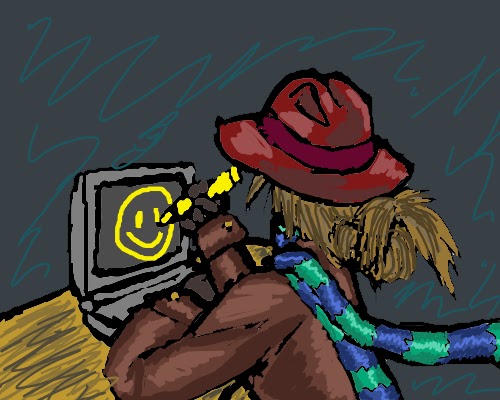 Crossing over to digital drawing when you've been used to traditional media is... weird. I digitized just a few months ago, and while it's been a bit tricky to learn, it hasn't been as bad as I thought it would be. If you're curious about going digital, read on! |
One thing's for sure, learning to draw directly in digital media has some definite advantages. One of my favorites is consistancy. You can't get the same pixel-by-pixel accuracy from scanning pencil drawings as you get from a digital picture. It's also especially handy to be able to draw lighter colors on top of darker colors. I personally couldn't have drawn the clouds in the picture to the right if I was using pencil. These two examples barely scratch the surface of what digital art has to offer, when you consider that there are an almost infinite number of effects, colors, and customizations you can use to bring the images in your brain to life. |  |
| The tricky part is more in the actual execution than anything else. Pixel Painting is an art all its own, and has all sorts of inherant quirks to it. Graphics tablets are hard to get used to at first. Most graphics tablets don't allow you to draw directly on the picture's surface. You hover the pen above your tablet to move the cursor, and you touch the pen to the surface to left-click/drag so you can draw. There are generally buttons on the pen that let you right- and middle-click, too. It's also good to unplug the mouse, so it doesn't accidentally jerk your cursor if you bump it. Most of this becomes almost as natural as using a pencil and paper, though, once you get familiar with it. The movement of the cursor itself works like a mouse, not a pen, as far as shapes are concerned. Speed matters. Move your pen faster, and the line is longer. Also, if you roll the pen so that the nib is in the same location, but still rubs against the drawing surface, your cursor will move and make a line. Because of this, shapes, lines, and general hand-eye coordination will take some re-learning. As for the programs used to draw, those are a whole other story. They range from being as simple as MS paint, to overflowing digital toolboxes of customizable brushes and colors. Photo editing programs look even more complicated, with layers, effects, and gizmos galore. I don't know much about them, but I know enough to figure out that there's a lot more potential in these softwares just waiting to be learned. |
 Digital art, I think, is one of those things that can be about as easy or as complicated as you want to make it. There's a lot to work with, and a lot to explore. Still, at the same time, you can make nice stuff with some of the most basic tools. One thing's for sure, there's a lot more to drawing on the computor than... meets the eye. :) |






No comments:
Post a Comment